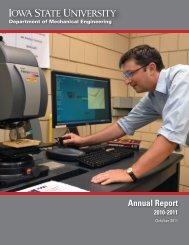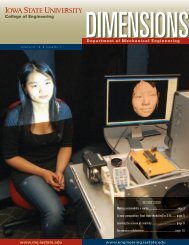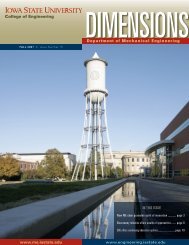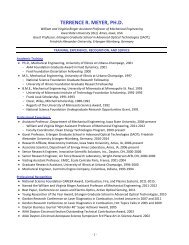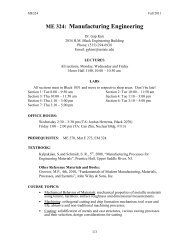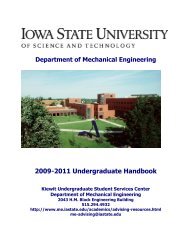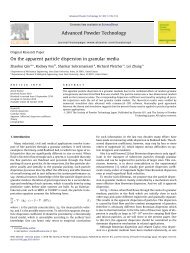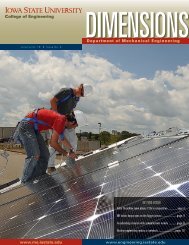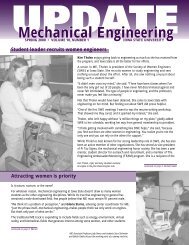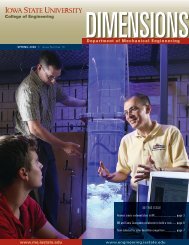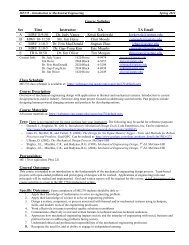Consider-then-Choose Models in Decision-Based Design ...
Consider-then-Choose Models in Decision-Based Design ...
Consider-then-Choose Models in Decision-Based Design ...
Create successful ePaper yourself
Turn your PDF publications into a flip-book with our unique Google optimized e-Paper software.
Fuel Consumption (gpm)<br />
0.12<br />
0.10<br />
0.08<br />
0.06<br />
0.04<br />
0.02<br />
0<br />
Fuel Consumption<br />
Fuel Economy<br />
4 6 8 10 12 14<br />
0-60 Acceleration (s)<br />
40<br />
35<br />
30<br />
25<br />
20<br />
15<br />
10<br />
5<br />
0<br />
Fuel Economy (mpg)<br />
Unit Cost (10 4 USD)<br />
3.0<br />
2.5<br />
2.0<br />
1.5<br />
1.0<br />
Fuel Economy (mpg)<br />
10 20 30 40 50 60 70<br />
Fuel Economy<br />
0-60 Acceleration<br />
4 6 8 10 12 14<br />
0-60 Acceleration (s)<br />
FIGURE 1. 0-60 acceleration versus fuel consumption (solid l<strong>in</strong>e)<br />
and fuel economy (dashed l<strong>in</strong>e) for the model used <strong>in</strong> Section 3; see<br />
Eqn. (24).<br />
FIGURE 2. Unit costs plotted as a function of 0-60 acceleration<br />
(solid l<strong>in</strong>e) and fuel economy (dashed l<strong>in</strong>e) for the model used <strong>in</strong> Section<br />
3; see Eqn. (25).<br />
<strong>Consider</strong>-<strong>then</strong>-choose choice probabilities are <strong>then</strong><br />
behavior, however, requires solv<strong>in</strong>g<br />
P C (a,g(a), p) =<br />
{<br />
P(a,g(a), p) if k(a, p) ≤ B<br />
0 if k(a, p) > B<br />
maximize<br />
P C (a,g(a), p)(p − c(a))<br />
with respect to 2.5 ≤ a ≤ 15, p ≥ 0<br />
(6)<br />
where P(a,g, p) is the Logit choice probability (with an outside<br />
good)<br />
eu(a,g,p)<br />
P(a,g, p) =<br />
1 + e u(a,g,p)<br />
and the utility function u depends on acceleration, fuel consumption,<br />
and vehicle price as follows:<br />
u(a,g, p) = −3.6p − 36.8g + 11.262<br />
a<br />
+ 23.2. (4)<br />
This utility model is based on the model estimated <strong>in</strong> [39].<br />
Optimal <strong>Design</strong>-and-Pric<strong>in</strong>g<br />
If the firm were to ignore consider-<strong>then</strong>-choose behavior,<br />
they would solve<br />
maximize<br />
P(a,g(a), p)(p − c(a))<br />
with respect to 2.5 ≤ a ≤ 15, p ≥ 0<br />
This is a smooth Nonl<strong>in</strong>ear Program (NLP) and is easily solved<br />
with exist<strong>in</strong>g techniques. Acknowledg<strong>in</strong>g consider-<strong>then</strong>-choose<br />
(5)<br />
an optimization problem with a discont<strong>in</strong>uous objective that cannot<br />
be solved with exist<strong>in</strong>g NLP techniques.<br />
We apply an ad hoc approach suitable for this problem. Because<br />
profits are zero if the budget constra<strong>in</strong>t is not satisfied<br />
(k(a, p) > B) but are positive for any choice of (a, p) such that<br />
p > c(a) and k(a, p) ≤ B, the budget constra<strong>in</strong>t must be satisfied<br />
by the optimal design and price. Thus Eqn. (6) can be solved by<br />
solv<strong>in</strong>g the constra<strong>in</strong>ed NLP<br />
maximize<br />
P C (a,g(a), p)(p − c(a))<br />
with respect to 2.5 ≤ a ≤ 15, p ≥ 0<br />
subject to B − k(a, p) ≥ 0<br />
The contours of the objectives, the budget constra<strong>in</strong>t, and the<br />
optimal solutions to Eqns. (5) and (7) are illustrated <strong>in</strong> Fig. 3.<br />
Solution details are given <strong>in</strong> Table 1. Eqn. (5) is solved by design<strong>in</strong>g<br />
a vehicle with 0-60 acceleration time of 4.5 seconds (with<br />
a correspond<strong>in</strong>g fuel economy of 10.2 mpg) and pric<strong>in</strong>g this vehicle<br />
at roughly $55,100. The expected profits with this design<br />
and price, normalized by market size, are roughly $27,700. However,<br />
this vehicle does not satisfy the budget constra<strong>in</strong>t. Thus, under<br />
consider-<strong>then</strong>-choose behavior, profits for this vehicle would<br />
be $0. Acknowledg<strong>in</strong>g consider-<strong>then</strong>-choose behavior by solv<strong>in</strong>g<br />
Eqn. (7) leads to a slightly higher price of $57,200, but a<br />
(7)<br />
4 Copyright c○ 2012 by ASME




